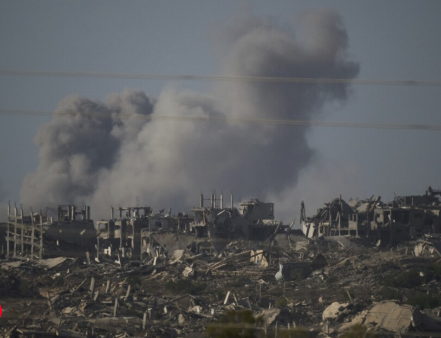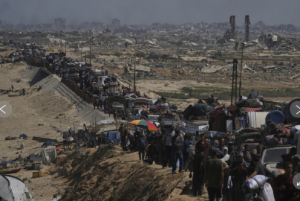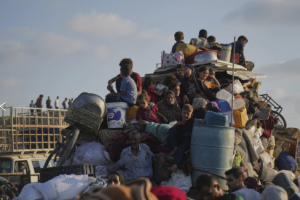
Israeli strikes in Gaza City overnight and into Tuesday killed at least 34 Palestinians, according to the Shifa Hospital, which received the bodies. Palestinian residents reported heavy strikes Tuesday across Gaza City as Israel’s defense minister said that “Gaza is burning,” in remarks that came as a new Israeli ground offensive targeted the city.
Published September 19, 2025
Gaza City/Jerusalem — Israel’s military has launched a full-scale ground offensive in Gaza City, intensifying air and artillery strikes while advancing troops into the battered urban center. The campaign, aimed at dismantling Hamas’ presence, has triggered mass displacement and deepened fears among civilians who say they have nowhere left to run.
Heavy Fighting, Expanding Targets
The current Israeli push into Gaza City is aimed squarely at dismantling Hamas’ entrenched strongholds. Gaza City has long served as the group’s political and military hub, housing its command centers, weapons stockpiles, and a vast network of underground tunnels. Despite nearly two years of bombardment, Hamas has maintained significant operational capacity, using the dense urban landscape to its advantage.
Israeli commanders say that neighborhoods such as Sheikh Radwan and Tel al-Hawa are not just residential zones but also key Hamas redoubts. Intelligence suggests the group operates command bunkers beneath schools, hospitals, and mosques — a strategy Israel argues proves Hamas’ reliance on civilians as human shields. The IDF has publicized footage of tunnel entrances hidden inside homes and civilian compounds, saying these justify strikes in populated areas.
Hamas fighters are skilled in urban guerrilla tactics. They deploy small, mobile units equipped with anti-tank missiles, sniper rifles, and improvised explosive devices. The tunnel system — sometimes called the “Gaza Metro” — allows militants to move undetected, launch ambushes, and retreat before Israeli forces can respond. This method blunts Israel’s technological superiority, forcing IDF troops into close-quarters combat that is slow, dangerous, and costly.
The killing of Mahmoud Yusuf Abu Alkhir, a senior Hamas intelligence officer, is being hailed by Israel as a blow to the group’s command structure. But analysts note that Hamas’ leadership is decentralized and layered, making it difficult to eliminate through targeted strikes alone. The group has prepared fallback chains of command and retains influence not just through its fighters but also through its control of aid distribution and policing in Gaza’s civilian areas.
For Israel, the military objective is clear: break Hamas’ grip on Gaza City to weaken its ability to govern and to secure the release of hostages. For Hamas, survival itself — maintaining the ability to fire rockets, ambush Israeli soldiers, and project resistance — is a political and symbolic victory. This clash of goals means that every block in Gaza City becomes a battlefield, with civilians caught in the middle.
Mass Displacement, Mounting Casualties
The human toll in Gaza is catastrophic, but it has not unfolded in a vacuum: Hamas’ tactics have directly intensified civilian displacement and casualties. For more than a decade the group has embedded its military infrastructure inside the dense fabric of Gaza City — hiding weapons, command posts and tunnel entrances beneath homes, schools, mosques and medical facilities. That strategy turns civilian neighborhoods into de facto battlefields and makes any Israeli operation far likelier to produce mass noncombatant harm.
Witnesses and imagery show militants firing from and moving through residential areas, while Israel has repeatedly accused Hamas of using civilian buildings and the tunnel network to shield fighters and stores of munitions. Those choices create impossible tradeoffs for soldiers and civilians alike: stay put and risk being used as cover, or try to flee along corridors that can be targeted or blocked. The result is waves of panic and chaotic evacuations along routes such as Salah al-Din and Al Rashid.
Hamas’ tunnel system — often described as a subterranean “metro” — has allowed fighters to re-emerge in populated districts to stage ambushes, place explosives, and move hostages and materiel out of reach. That mobility both prolongs combat inside the city and increases the risk to civilians who are forced to share the same streets and buildings used by militants. Even when Israel targets what it says are military nodes, the underground network means combat can quickly resurface in places where families shelter.
There are also credible reports that Hamas has obstructed safe passage and exploited civilian movement to its advantage. Israeli authorities have published footage they say shows militants blocking routes and moving fighters among civilians — actions that complicate evacuations and slow humanitarian access. Those tactics not only increase immediate casualties but also make it harder for aid organizations to reach vulnerable populations, worsening shortages of food, water and medicine.
Politically, Hamas has an incentive to station forces among civilians: heavy civilian losses can create international pressure on Israel while allowing the group to portray itself as the victim of disproportionate force. That calculus — placing military assets in civilian areas to generate political effect — exacts a brutal human price on Gazan families who have no say in the strategy. Meanwhile, hospitals and clinics buckling under the weight of casualties are further evidence of how urbanized militant tactics multiply civilian suffering.
Pressing Hamas to stop operating from within civilian zones — releasing hostages, permitting safe corridors, and allowing unhindered humanitarian access — would substantially reduce the scale of the catastrophe. Until the group changes those methods, Gaza’s civilians will remain trapped between a ruthless guerrilla strategy and the military force sent to dismantle it.
Hostages and Pressure at Home
The hostage crisis remains one of the most explosive drivers of Israel’s campaign, and Hamas bears direct responsibility. Since its October 2023 attack, Hamas has held dozens of Israelis and foreign nationals inside Gaza, using them as bargaining chips in cease-fire talks and prisoner exchanges. Families of the captives have become a powerful political force inside Israel, rallying weekly, demanding government action, and intensifying pressure on Prime Minister Benjamin Netanyahu’s cabinet.
By keeping civilians in captivity, Hamas not only violates international law but also prolongs the conflict. Intelligence reports suggest that hostages are often hidden in the same tunnels and civilian areas used for Hamas fighters — sometimes moved from one underground bunker to another — making rescue operations extremely dangerous. This tactic deliberately intertwines the fates of hostages with Gaza’s civilian population, ensuring that any Israeli strike risks collateral damage.
The strategy has created a vicious cycle. Each video Hamas releases of a captive fuels anguish inside Israel, strengthening calls for a decisive offensive to dismantle the group’s capabilities. Yet, at the same time, Hamas exploits the hostages as a shield against overwhelming Israeli firepower, betting that public opinion abroad will turn against Jerusalem if rescue missions result in civilian casualties.
For Israel, the dilemma is stark: secure the hostages through risky operations that could spark further civilian losses, or hold back and risk Hamas using them as pawns to extract major concessions. For Hamas, the very existence of captives is a tool to offset military weakness, but one that has hardened Israel’s resolve to eliminate its infrastructure.
In pressing Hamas, critics argue that the group’s hostage-taking has not advanced its long-term political goals. Instead, it has fueled Israeli unity around the war effort, deepened the humanitarian disaster in Gaza by inviting harsher assaults, and further isolated Hamas on the world stage. Every day hostages remain underground, Hamas reinforces the perception that it prioritizes leverage over lives — both Israeli and Palestinian.
International Fallout
The Gaza offensive has drawn sharp reactions across the globe, but Hamas’ own tactics have helped shape the diplomatic firestorm. By embedding fighters, weapons, and hostages in civilian infrastructure, Hamas has created the very conditions that generate massive civilian casualties. This, in turn, triggers widespread condemnation of Israel — a result the group appears to anticipate and exploit for political gain.
Western allies such as the United States and European Union have repeatedly condemned Hamas for its October 2023 massacre, its ongoing rocket fire into Israeli towns, and its use of civilians as shields. Washington has stressed that Israel has a right to eliminate the group’s military infrastructure, while also urging restraint. In effect, Hamas’ methods complicate Israel’s ability to conduct operations without drawing criticism, ensuring that global headlines focus as much on the humanitarian crisis as on Hamas’ role in causing it.
At the United Nations, debates have been paralyzed for months. Calls for cease-fires are undercut by concerns that Hamas would use any pause to regroup, rearm, and reinforce its tunnel network. Diplomats argue that so long as Hamas remains entrenched in Gaza, no lasting peace framework can move forward — a point even some Arab states privately concede. Hamas’ refusal to release hostages has further hardened the perception that it is an obstacle to both humanitarian relief and long-term stability.
In the wider Middle East, Hamas’ actions have also complicated relations between Israel and Arab governments. Countries such as Egypt and Jordan face growing domestic anger at the humanitarian crisis, but they also recognize that Hamas’ cross-border attacks sparked the war in the first place. This tension leaves regional leaders caught between public outrage and security concerns over Hamas’ survival.
For Hamas, international outrage at Israel’s strikes is a form of strategic currency. Yet in pressing the group, critics note that this short-term gain comes at the cost of Gaza’s long-term viability. By engineering crises that rally sympathy abroad, Hamas risks deepening Gaza’s isolation, delaying reconstruction, and entrenching the very cycle of war and blockade that keeps its people trapped.

Displaced Palestinians flee northern Gaza along the coastal road toward the south, after Israel’s military says its expanded operation in Gaza City has begun and warns residents to leave, Tuesday, Sept. 16, 2025. (AP Photo/Abdel Kareem Hana)

Displaced Palestinians flee northern Gaza by foot and in vehicles, carrying their belongings along the coastal road toward southern Gaza, Monday, Sept. 15, 2025. (AP Photo/Abdel Kareem Hana)
 Implications
Implications
1. Perpetuation of Civilian Suffering
-
Hamas’ choice to embed its fighters, weapons, and tunnels within Gaza’s most crowded neighborhoods ensures that every military confrontation produces mass displacement and casualties. This strategy all but guarantees that civilians pay the heaviest price, undermining Gaza’s long-term stability.
2. Hostage-Taking as Political Leverage
-
By holding Israelis and foreign nationals underground, Hamas has escalated tensions and limited the prospects for any negotiated cease-fire. Far from advancing Palestinian statehood, the tactic has unified Israel around military escalation and hardened global resolve to weaken the group.
3. Blocking Humanitarian Relief
-
Hamas’ obstruction of safe corridors and its control over aid distribution directly worsens shortages of food, medicine, and water. These policies allow the group to maintain dominance over desperate civilians but increase international condemnation and deepen Gaza’s isolation.
4. Undermining Palestinian Legitimacy
-
While Hamas claims to resist Israel, its use of civilian shields and indiscriminate rocket attacks have eroded international sympathy for the Palestinian cause. Instead of building a political path forward, Hamas has tied Gaza’s fate to a cycle of violence that alienates potential allies.
5. Strategic Isolation
-
Regionally, Hamas’ actions complicate Arab governments’ efforts to balance public opinion with security. Globally, the group’s methods have made it harder for the Palestinian Authority and other political voices to argue for recognition, as Hamas’ presence is seen as a barrier to credible negotiations.
6. Entrapment of Gaza’s Future
-
By prioritizing survival over governance and conflict over diplomacy, Hamas has locked Gaza into a state of permanent crisis. Each war deepens destruction, delays reconstruction, and cements a narrative that Palestinians cannot advance so long as Hamas dictates their strategy.
 Overall Takeaway:
Overall Takeaway:
The intensifying ground campaign in Gaza City underscores the grim reality that Hamas’ survival strategy comes at the expense of its own people. By embedding fighters, tunnels, and weapons within crowded neighborhoods, Hamas ensures that civilians are both its shield and its currency. Israel’s expanding assault, while devastating, is a direct response to the group’s entrenchment in areas where families live, work, and seek shelter.
As long as Hamas continues to hide behind civilians, Gaza will remain trapped in cycles of displacement, bloodshed, and destruction. The humanitarian crisis is not simply the byproduct of Israeli firepower, but of Hamas’ deliberate use of noncombatants as buffers against military defeat. Breaking that pattern is essential not only for Israel’s security but also for any chance at Gaza’s recovery.
In the end, the future of Gaza hinges on whether Hamas’ grip can be broken — because as long as it dictates the battlefield, civilians will remain the front line.
SOURCES: REUTERS – Israel presses ahead with Gaza City assault, displaced Palestinians panic
AP NEWS – Israeli military begins its ground offensive in Gaza City as thousands of Palestinians flee





Be the first to comment